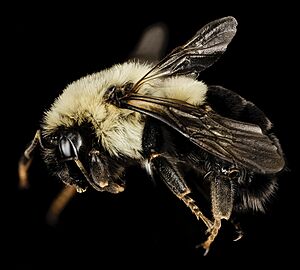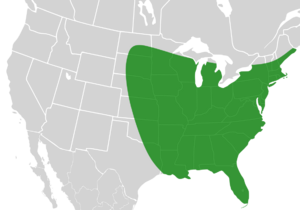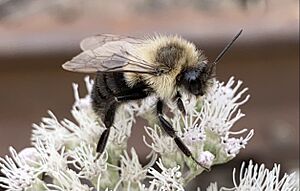Common eastern bumblebee facts for kids
Quick facts for kids Common eastern bumblebee |
|
|---|---|
 |
|
| Queen | |
| Conservation status | |
| Scientific classification | |
| Genus: |
Bombus
|
| Species: |
impatiens
|
 |
|
| US range of Bombus impatiens | |
The common eastern bumble bee, also known as Bombus impatiens, is a very common bumblebee. You can find them across eastern North America. They live in the eastern United States, southern Canada, and the eastern Great Plains. These bees are very good at adapting. They can live in the countryside, in suburbs, and even in big cities.
Because they adapt so well, they are excellent pollinators. This means they help plants grow by carrying pollen. People use them a lot in greenhouses to pollinate crops. This has helped them spread to new areas. Bombus impatiens is one of the most important pollinator bees in North America.
Contents
About Their Name

The scientific name for this bee is Bombus impatiens. The first part, Bombus, is the name for all bumblebees. They belong to a group called Bombini. The second part, impatiens, might come from the Impatiens flowers. These flowers are one of the bees' food sources.
There are about 250 different species in the Bombus group. Most of these bees live in groups, like a family. This is called eusociality. Bombus impatiens belongs to a smaller group called Pyrobombus. These bees are also part of the Hymenoptera order and the Apidae family.
What They Look Like
Queens, Workers, and Males
Bombus impatiens bees look a bit like other bumblebees. These include B. bimaculatus and B. vagans. They have short, even hair. Their heads are medium-sized. Their bodies are long and rectangular.
Queens and workers look very similar in color and hair. However, queens are much bigger. A queen is about 17–23 mm long. Workers are smaller, about 8.5–16 mm long. Males are 12–18 mm long.
Queens and workers are mostly black. They have a yellow patch on their upper body (thorax) and the first part of their belly. Males are a bit different. They have a yellow face and head.
Their Nests
Bombus impatiens bees build their nests underground. These nests are usually 1–3 feet below the surface. They use tunnels to get in and out. These tunnels can be from 18 inches to 9 feet long.
Unlike honeybees, their nests don't have a clear pattern. The bees lay egg clumps all over the nest. There isn't just one main area for the young bees.
Inside the nest, bees have special jobs. Some workers stay in small areas. All workers keep a certain distance from the center of the colony. Smaller bees tend to stay closer to the center. Bees that feed the young are found in the middle. Foragers, who go out to find food, are usually near the edges when they are not outside.
Where They Live
These bees live in the Eastern temperate forest region. This includes the eastern United States, southern Canada, and the eastern Great Plains. You can find them in many states. These include Ontario, the New England States, Georgia, Florida, Michigan, and Kansas.
Because people use them in greenhouses, they have spread to new places. Bombus impatiens can live in many different places. They visit many kinds of plants for food. They do well in farms, wet areas, cities, and even wooded areas. They build their underground nests in open fields and woods.
Their Colony Life
Queens, also called gynes, start new colonies. They usually leave their winter resting spots (called hibernacula) in mid-April. They then set up their new colonies in May.
Worker bees start to appear in early June. Male bees and young queens begin to show up in August and September. Sometimes, bees can emerge as late as mid-October. A Bombus impatiens colony can have more than 450 bees. Most of these are worker bees.
How They Behave
Jobs in the Nest
Worker bees in the nest spread out in a special way. They keep a certain distance from the center of the nest. This helps them work more efficiently. It means they don't have to travel far between tasks.
Their jobs are often linked to their size. Smaller bees usually stay near the center of the nest. Their job is to feed the young bees (larvae). Bigger workers are usually found at the edges. They work as foragers, finding food, and as guards. Generally, they keep their special area and job for their whole lives.
Queen's Control
Worker bees can lay eggs. Some even have eggs ready in their bodies. But when a queen is in the colony, the workers usually don't try to lay eggs. They also don't fight with other workers or the queen. If there is no queen, fighting among workers is more common.
Mating
A young queen mates with a male bee near the end of the hive's life. They usually mate on the ground or on plants. Mating can last from 10 to 80 minutes. After mating, the young queens go into hibernation for the winter.
The next spring, they wake up. They eat nectar to get strong. Then they look for a good spot to start a colony. This is often an old mouse or chipmunk hole. The first thing a queen builds is a "honeypot." She fills it with nectar and pollen. This food helps her feed her first young bees. She raises these young in paper cells she builds. A queen can lay about 2000 eggs in one season. But only about half of them will grow into adult bees.
Finding Food
Traplining
Bombus impatiens foragers use a smart way to find food called traplining. This means they visit their food sources in the same order every time. This helps them be more efficient, especially in new places. They create these traplines by searching flowers in an organized way. Once they set up a trapline, they stick to it for a long time.
Traplining has many benefits. Bees can fly shorter distances by connecting food sources directly. They also save time because they know where the food is. Plus, they can avoid places that have just run out of nectar or pollen.
Talking About Food
Bombus impatiens bees communicate to get the most out of finding food. As they get better at foraging, they become faster and more accurate. When foragers return to the nest, they often encourage other bees to go out and find food.
They also share information about good food sources. They can tell each other about the scents of flowers that have lots of nectar or pollen. This helps the whole colony find food more effectively.
How They Interact with Others
What They Eat
Bombus impatiens bees eat from many different plants. Some of their favorite food plants include Aster, Cirsium, Eupatorium, and Solidago (goldenrod). They also like clover, purple vetch, and Impatiens flowers.
The bees can eat pollen and nectar directly from flowers. But most bees in the colony eat honey. Honey is made from pollen and nectar and has more nutrients. To make honey, bees eat pollen and nectar. Then they bring it back up (regurgitate) and mix it with special enzymes from their stomachs.
Parasites
Bombus impatiens bees can be hosts to other bees, like Ps. Laborious and Bombus citrinus. These are like guests living off them. Scientists have also found tiny viruses and bacteria in the workers. But these don't seem to harm Bombus impatiens bees.
Why They Are Important to Humans
Bees are very important for pollinating crops. If there are fewer bees, farmers get less food from their crops. This can lead to less food for people and financial problems for farmers.
Bombus impatiens bees are raised commercially. They are one of the most important pollinator bees used by the greenhouse industry in North America. This includes Canada and Mexico. They are good at pollinating and are native to eastern North America.
People are even more interested in Bombus impatiens now. This is because other pollinator bees, like A. mellifera (honeybees), are declining. Also, it's not allowed to bring B. terrestris into North America. Bombus impatiens bees are used to pollinate crops like tomatoes, blueberries, raspberries, and pumpkins.



